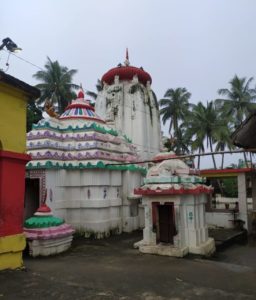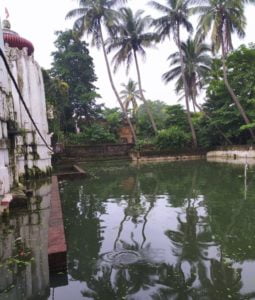13th Century Sacred Pond In Bhubaneswar Wallows In Neglect, Threat To Temple Complex

Bhubaneswar: A sacred pond dating back to the 13th Century in the city has turned into a cesspool of stagnant water today due to lack of maintenance and bad planning.
Locals complained that the exit channel of Gosagareswara Pond, which is located around 800 metres west of Lingaraj Temple, has been blocked since the past few years. As a result, the water level has risen and enters the adjoining temple complex during the rainy season.
According to old timers, the pond is fed by a natural underground spring and the overflow was discharged into Bindu Sagar through a channel on the north-eastern corner. For centuries, the water level in the tank remained constant with the inflow and outflow being maintained. But things have literally gone down the drain in the past few years.

The Gosagareswara complex consists of eleven temples dedicated to various divinities. While the presiding deity is Lord Shiva, the other temples which include the Isaneswara, Narashimha, Paradesvara and the Sanisvara Temples too have Shivalings in them. Three temples are abandoned and a large Mandap of a later period too exists.
Experts have warned that the Gosagareswara tank should be repaired immediately otherwise all the temples in the complex are at risk.
The constant accumulation of water in the tank submerges the base of the main temple and is rendering the foundation weak and many cracks have developed. Water seeps into the ‘garbhagrihas’ (sanctum sanctorum) of nearly all the temples in the complex. Constant water logging has resulted in a high ground water level and an old mandap can be seen leaning to one side.
The water in the pond is highly polluted with micro hydrophytic organisms floating on the surface. Many of the locals who used the tank for their daily baths have stopped using it. Earlier it was also a source of drinking water. Even a well inside the complex is now contaminated due to the high ground waterline.

The temple was last repaired by the State Archaeology Department in 1999. A compound wall was constructed to stop the natural flow of water. At present, the temple keepers pump out the water at regular intervals, but it is hardly effective.
The locals claimed that they have intimated the authorities many times, but to no avail. If immediate measures are not undertaken, much damage will happen to the temples as the foundations will be severely affected, they said.
Prafulla Swain, the secretary of Maa Jageswari Youth Association, said they undertook cleaning of the accumulated sludge in the tank many times, but if permanent corrective measures are not taken, a lot of damage may happen. He also pointed out to the widening cracks on the temple sides.
The project co-ordinator of Indian National Trust for Art and Cultural Heritage (INTACH), Anil Dhir, is of the opinion that nearly all the holy tanks of the Old Town are all in a very advanced state of disrepair and neglect. Ganga-Yamuna, Bada Kua and Kapila Kunda of Kapileswar, Manikarnika, Kukutesvara, the tanks in the Kedar Gouri and Mukteswar Complex, Kotitirtha, Papanasini, Sunderesvara, Yamesvara, Mahabhoisasan and the Godavari tank are all in an advanced of decay and need immediate attention. They have now turned into garbage dumps with floating plastics and household waste.
According to noted environmentalist Dr Biswajit Mohanty, rampant digging of bore wells has rendered many of the natural springs dry. In some areas, the locals have formed Sahi committees and stopped the sinking of new bore wells. Mohanty said local clubs can be roped in for voluntary service to clean and de-silt these water bodies.

Comments are closed.